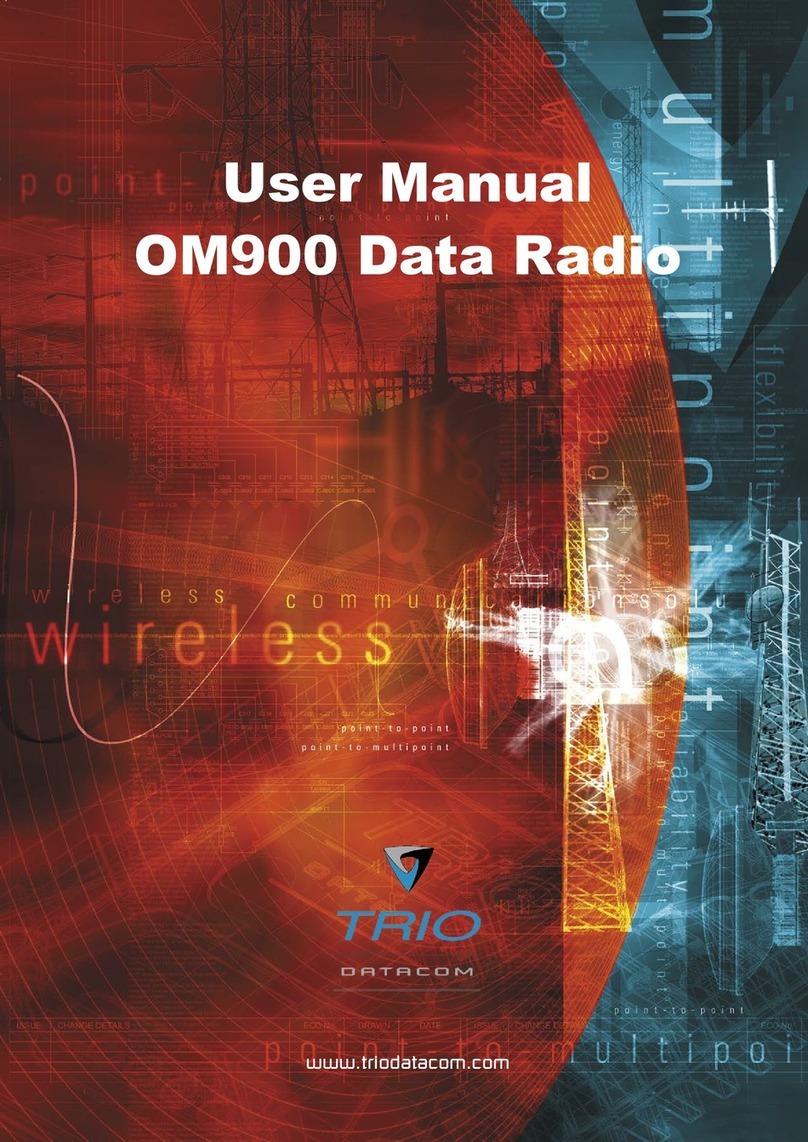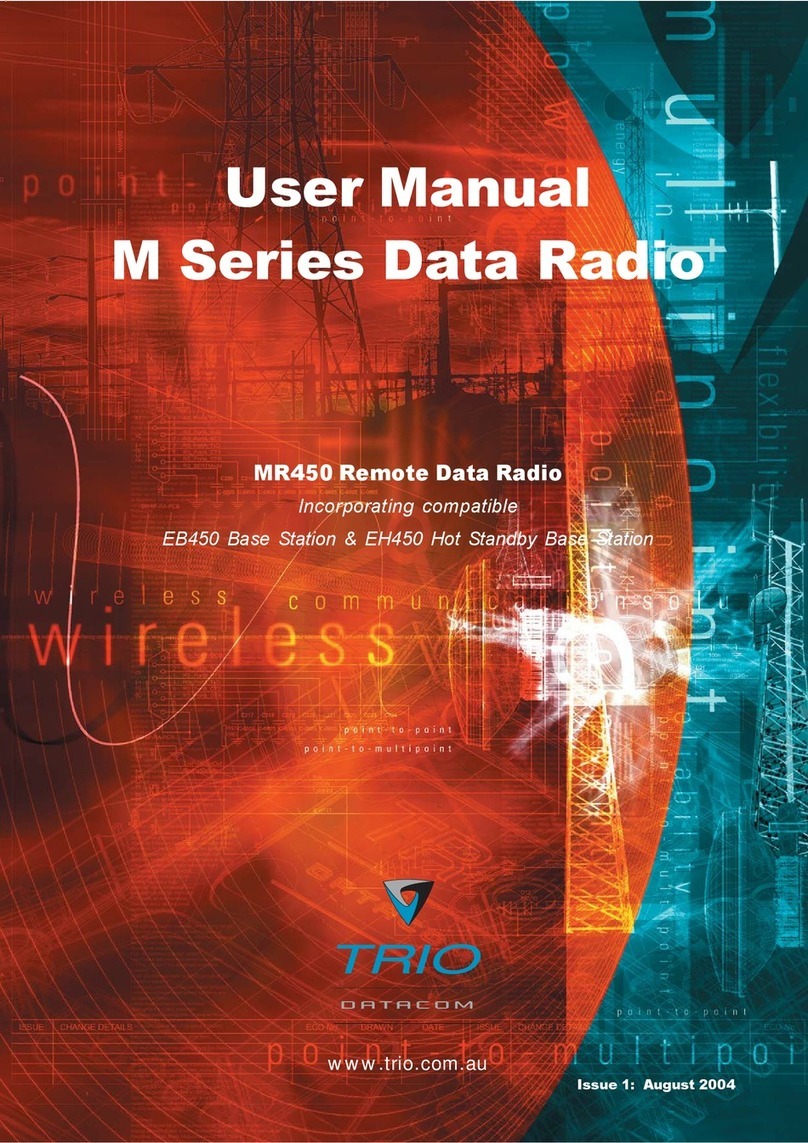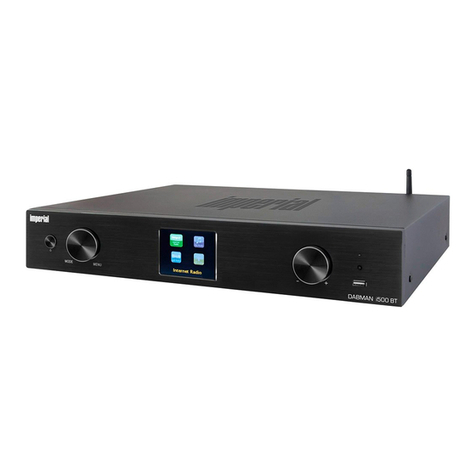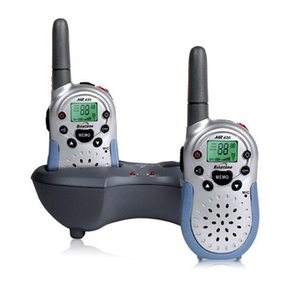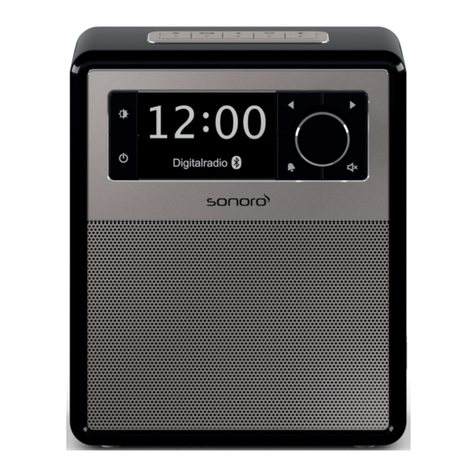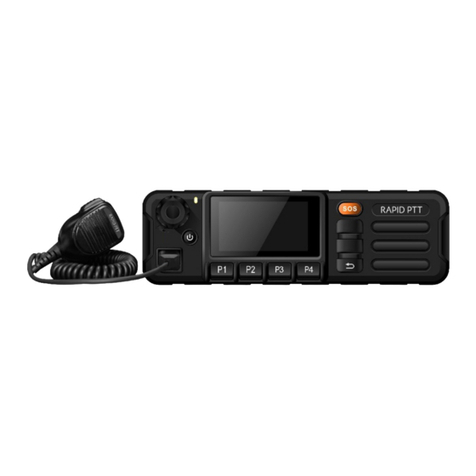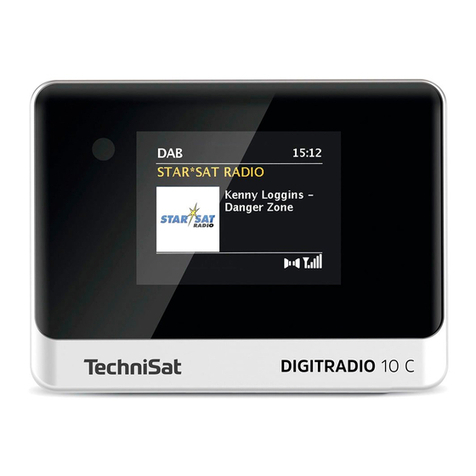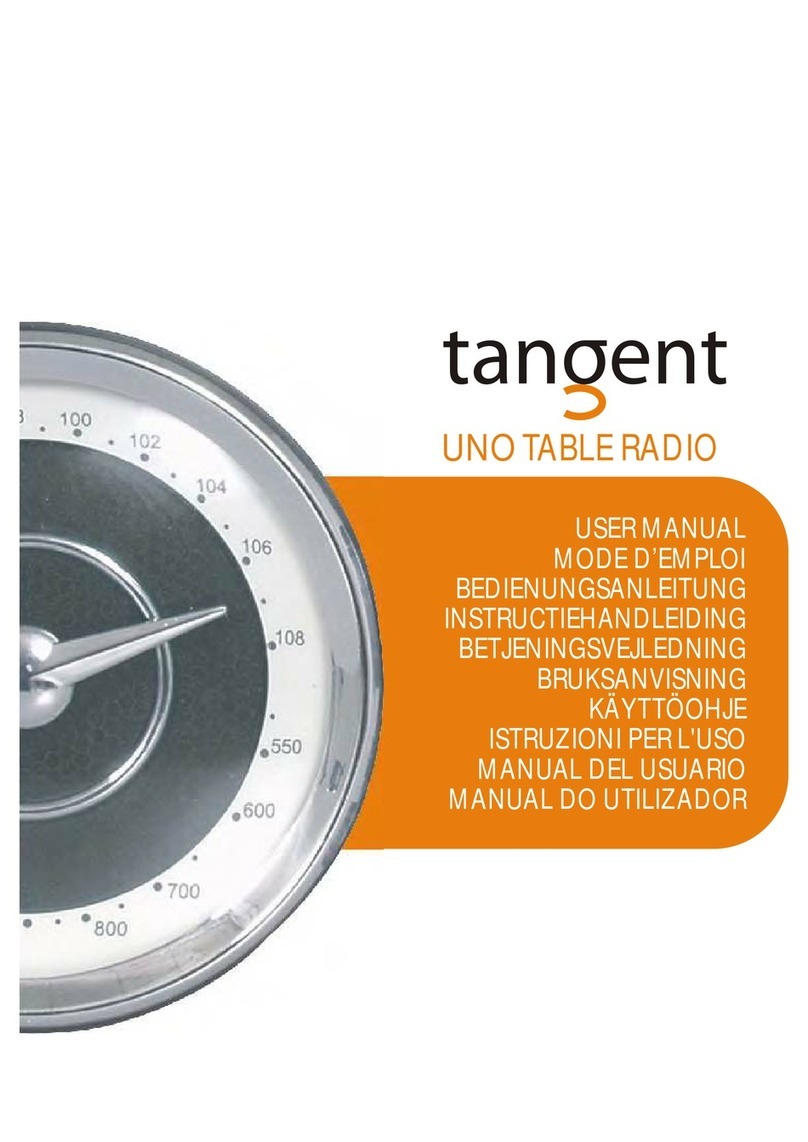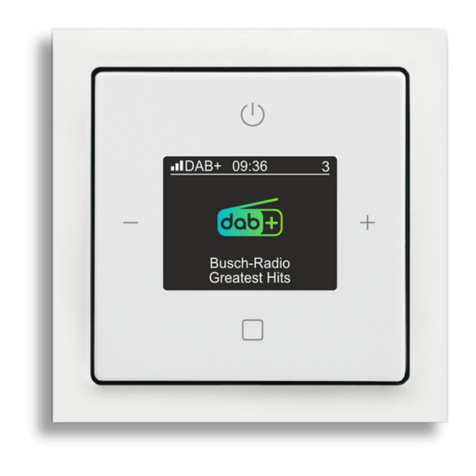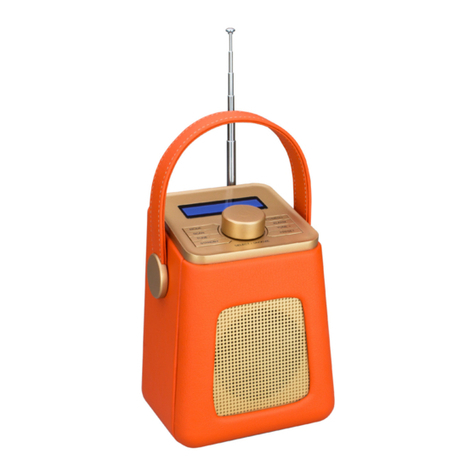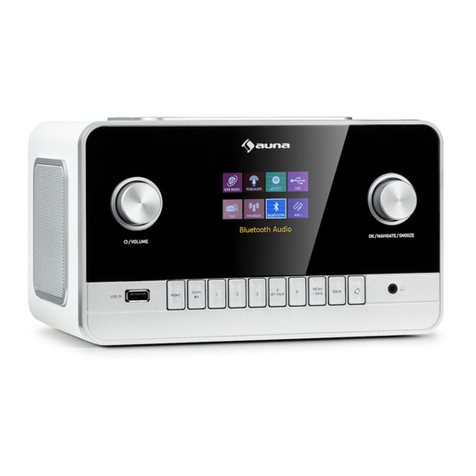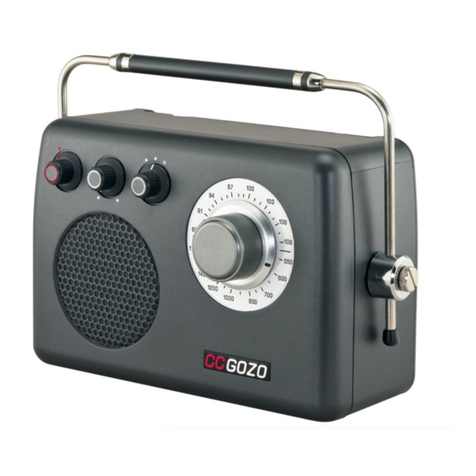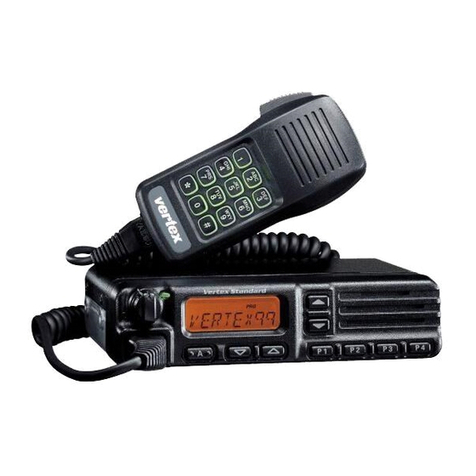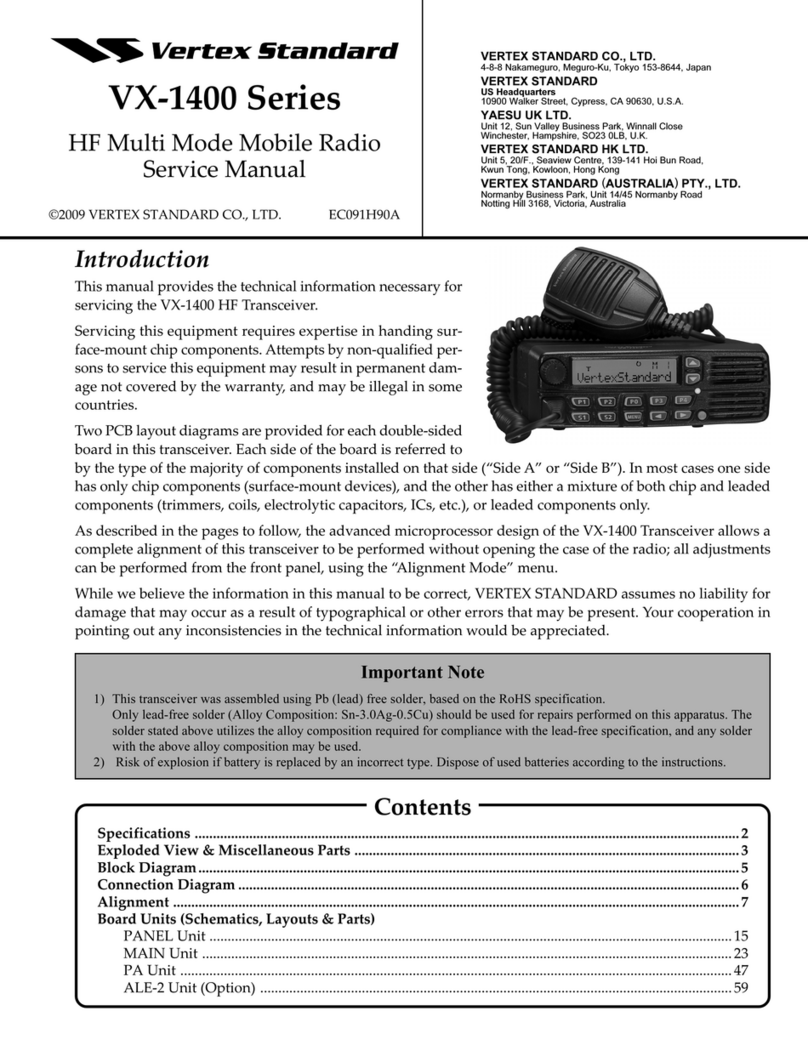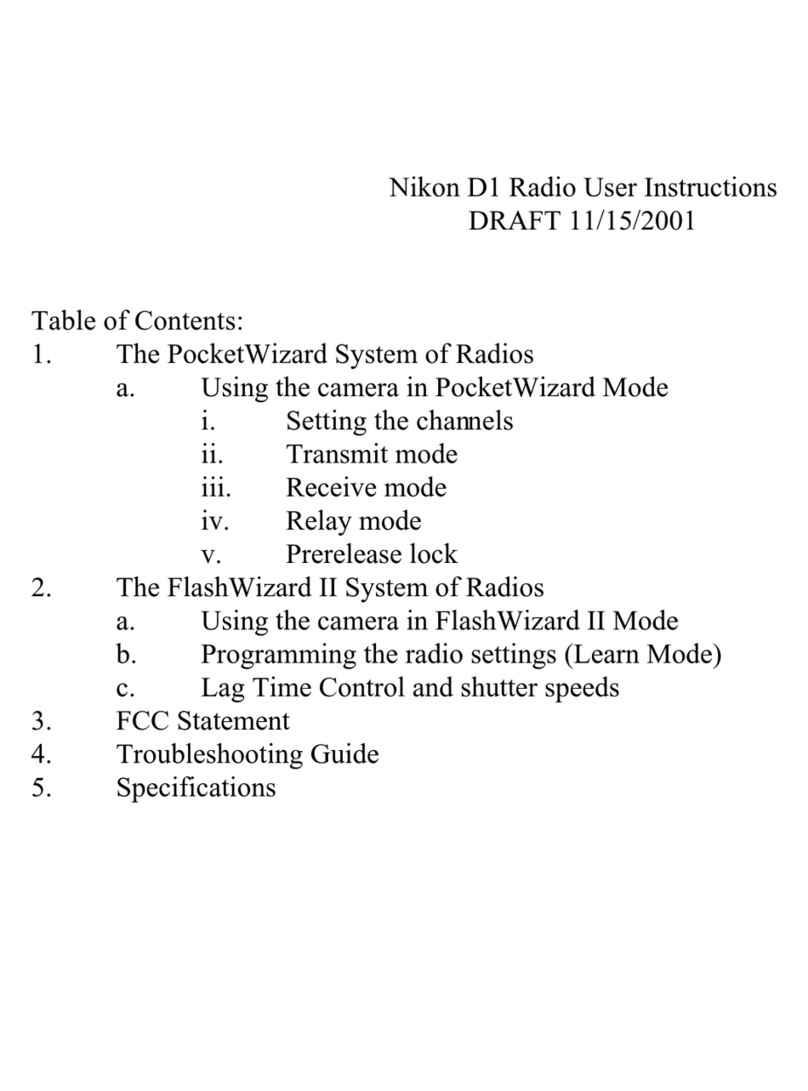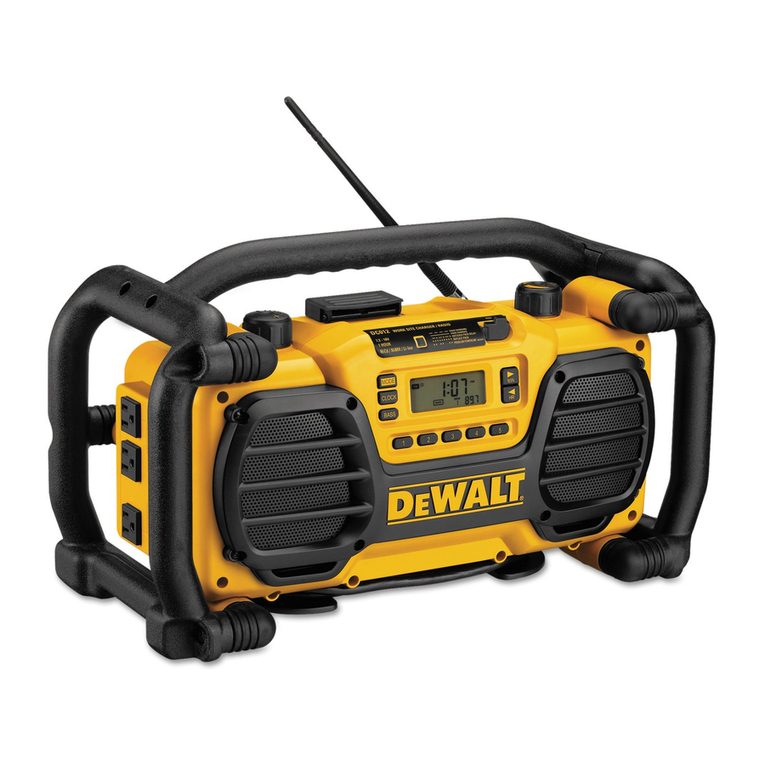Trio Datacom E Series User manual

Page 1
E Series Data Radio User Manual
© Copyright 2004 Trio DataCo Pty. Ltd.
User Manual
E Series Data Radio
www.trio.com.au
ER450 Remote Data Radio
EB450 Base Station
EH450 Hot Standby Base Station
Issue 5: February 2004

Page 2
E Series Data Radio User Manual
© Copyright 2004 Trio DataCo Pty. Ltd.
Part I TVIEW+ Management Suite -
Programmer 42
Introduction 42
Installation 42
TVIEW+ Front Panel 43
Programmer 43
Part TVIEW+ Management Suite -
Remote Diagnostics &
Network Controller 55
Introduction 55
System Description 55
perating Instructions 57
Interpreting Poll Results 69
pen Database Connectivity ( DBC) 70
Microsoft Excel Database Query Example 71
Part K Appendices 75
Appendix A - Application and Technical Notes 75
Appendix B - Slip Protocol 75
Appendix C - Firmware Updates 76
Appendix D - Microsoft Access (.mdb) Structure 78
Part L Specifications 83
ER450 Specifications 83
EB450 Specifications 84
EH450 Specifications 85
Part M Support Options 86
Website Information 86
E-mail Technical Support 86
Telephone Technical Support 86
Contacting the Service Department 86
Contents
SECTION 1 3
Part A Preface 4
Warranty 4
Important Notice 4
Warning - RF Exposure 4
Compliance Information 4
Related Products 5
ther Related Documentation and Products 5
Revision History 5
Part B E Series Overview 6
Definition of E Series Data Radio 6
E Series Product Range 6
E Series Features and Benefits 6
Model Number Codes 8
Standard Accessories 9
Part C Applications 10
Application Detail 10
Systems Architecture 11
Part D System Planning and Design 13
Understanding RF Path Requirements 13
Examples of Predictive Path Modelling 14
Selecting Antennas 16
Data Connectivity 17
Power Supply and Environmental Considerations 20
Physical Dimensions - Remote Data Radio - ER450 21
Physical Dimensions - Base Station - EB450 22
Physical Dimensions - Hot Standby Base Station - EH450 23
Part E Getting Started 24
ER450 Quick Start Guide 24
EB450 Quick Start Guide 30
EH450 Quick Start Guide 33
Part F - Operational Features 38
Multistream functionality (SID codes) 38
Collision Avoidance (digital and RFCD based) 38
Digipeater peration 38
TVIEW+ Diagnostics 38
Poor VSWR Sensing 38
Part G Commissioning 39
Power-up 39
LED Indicators 39
Data Transfer Indications 39
Antenna Alignment and RSSI Testing 39
Link Establishment and BER Testing 39
VSWR Testing 39
Part H Maintenance 40
Routine Maintenance Considerations 40
SECTION 2 41

Page 3
E Series Data Radio User Manual
© Copyright 2004 Trio DataCo Pty. Ltd.
SECTION 1
Part A - Preface
Part B - E Series Overview
Part C - Applications
Part D - System Planning an Design
Part E - Getting Starte
Part F - Operational Features
Part G - Commissioning
Part H - Maintenance

Page 4
E Series Data Radio User Manual
© Copyright 2004 Trio DataCo Pty. Ltd.
Warranty
All equip ent supplied by Trio DataCo Pty Ltd is warranteed against
faulty work anship and parts for a period of twelve (12) onths fro
the date of delivery to the custo er. During the warranty period Trio
DataCo Pty Ltd shall, at its option, repair or replace faulty parts or
equip ent provided the fault has not been caused by isuse,
accident, deliberate da age, abnor al at osphere, liquid i ersion
or lightning discharge; or where atte pts have been ade by
unauthorised persons to repair or odify the equip ent.
The warranty does not cover odifications to software. All equip ent
for repair under warranty ust be returned freight paid to Trio DataCo
Pty Ltd or to such other place as Trio DataCo Pty Ltd shall
no inate. Following repair or replace ent the equip ent shall be
returned to the custo er freight forward. If it is not possible due to the
nature of the equip ent for it to be returned to Trio DataCo Pty Ltd,
then such expenses as ay be incurred by Trio DataCo Pty Ltd in
servicing the equip ent in situ shall be chargeable to the custo er.
When equip ent for repair does not qualify for repair or replace ent
under warranty, repairs shall be perfor ed at the prevailing costs for
parts and labour. Under no circu stances shall Trio DataCo Pty
Ltds liability extend beyond the above nor shall Trio DataCo Pty
Ltd, its principals, servants or agents be liable for the consequential
da ages caused by the failure or alfunction of any equip ent.
Important Notice
© Copyright 2002 Trio DataCom Pty Ltd All Rights Reserved
This anual covers the operation of the E Series of Digital Data
Radios. Specifications described are typical only and are subject to
nor al anufacturing and service tolerances.
Trio DataCo Pty Ltd reserves the right to odify the equip ent, its
specification or this anual without prior notice, in the interest of
i proving perfor ance, reliability or servicing. At the ti e of
publication all data is correct for the operation of the equip ent at the
voltage and/or te perature referred to. Perfor ance data indicates
typical values related to the particular product.
This anual is copyright by Trio DataCo Pty Ltd. All rights
reserved. No part of the docu entation or the infor ation supplied
ay be divulged to any third party without the express written
per ission of Trio DataCo Pty Ltd.
Sa e are proprietary to Trio DataCo Pty Ltd and are supplied for the
purposes referred to in the acco panying docu entation and ust not
be used for any other purpose. All such infor ation re ains the
property of Trio DataCo Pty Ltd and ay not be reproduced, copied,
stored on or transferred to any other edia or used or distributed in
any way save for the express purposes for which it is supplied.
Products offered ay contain software which is proprietary to Trio
DataCo Pty Ltd. However, the offer of supply of these products and
services does not include or infer any transfer of ownership of such
proprietary infor ation and as such reproduction or reuse without the
express per ission in writing fro Trio DataCo Pty Ltd is forbidden.
Per ission ay be applied for by contacting Trio DataCo Pty Ltd in
writing.
Part A - Preface
Warning - RF Exposure
The radio equip ent described in this user anual e its low level
radio frequency energy. The concentrated energy ay pose a health
hazard depending on the type of antenna used. In the case of:
Non-directional antenna - DO NOT allow people to co e within 0.5
etres (20 inches) of the antenna when the trans itter is operating
Directional antenna - DO NOT allow people to co e within 6 etres
(20 feet) of the antenna when the trans itter is operating.
Compliance Information
FCC Notice (Hot Standby Controller Only)
This equip ent has been tested and found to co ply with the li its for
a Class B digital device, pursuant to Part 15 of the FCC Rules. These
li its are designed to provide reasonable protection against har ful
interference in a residential installation. This equip ent generates,
uses, and can radiate radio frequency energy and, if not installed and
used in accordance with the instruction, equip ent ay cause har ful
interference to radio co unications. However, there is no guarantee
that interference will not occur in a particular installation. If this
equip ent does cause har ful interference to radio or television
reception, which can be deter ined by turning the equip ent off and
on, the user is encouraged to try to correct the interference by one or
ore of the following easures:
Re-orient to relocate the receiving antenna.
Increase the separation between the equip ent and receiver.
Connect the equip ent into an outlet on a circuit different to that
which the receiver is connected.
Consult the dealer or an experienced radio/television technician
for assistance.
IC Notice (Hot Standby Controller Only)
This Class B digital apparatus co plies with Canadian ICES-003.
Cet appariel nu erique de la class B est confor e a la nor e NBM-
003 du Canada.
R&TTE Notice (Euro e)
In order to co ply with the R&TTE (Radio & Teleco unications
Ter inal Equip ent) directive 1999/5/EC Article 3 (Low Voltage
Directive 73/23/EEC), all radio ode installations ust include an
external in-line lightning arrestor or equivalent device that co plies
with the following specifications:
DC Blocking Capability - 1.5kV i pulse (Rise Ti e 10 S,
Fall Ti e 700 S) (Repetition 10 Ti es) or 1.0kV r s 50Hz
sine wave for 1 inute.
Part A Preface

Page 5
E Series Data Radio User Manual
© Copyright 2004 Trio DataCo Pty. Ltd.
Part A - Preface
Related Products
ER450 Re ote Data Radio
EB450 Base/Repeater Station
EH450 Hot Standby Base Station
Other Related Documentation
and Products
E Series Quick Start Guides
TVIEW+ Manage ent Suite
Digital Orderwire Voice Module (EDOVM)
Multiplexer Strea Router (MSR)
Re ision History
Issue 1 July 2002 Intitial Release
Issue 2 August 2002 Added EH450 Quick Start Section
and Specifications Section
Issue 3 Nove ber 2002 Major Edits to TVIEW and inor edits
to quick start sections.
Issue 4 June 2003 Major edits to TVIEW and Hot
Standby Controller sections.
Issue 5 February 2004 Additional radio and progra er
infor ation

Page 6
E Series Data Radio User Manual
© Copyright 2004 Trio DataCo Pty. Ltd.
Part B E Series Overview
Definition of E Series Data Radio
The E Series is a range of wireless ode s designed for the
trans ission of data co unications for SCADA, tele etry and any
other infor ation and control applications that utilise ASCII essaging
techniques. The E Series uses advanced digital odulation and
signal processing techniques to achieve exceptionally high data
throughput efficiency using traditional licensed narrow band radio
channels.
These products are available in any frequency band and regulatory
for ats, to suit spectru bandplans, in various continental regions.
The range is designed for both fixed point to point (PTP), and ultiple
address (MAS) or point to ultipoint (PMP) syste s.
E Series Product Range
The E Series range consists of the basic half duplex Re ote radio
ode , an extended feature full duplex Re ote radio ode , and
ruggedised Base Station variants, including an optional Hot Standby
controller to control two base station units in a redundant configuration.
Frequency band variants are indicated by the band prefix and odel
nu bering. (See Model Nu ber Codes)
Part B E Series Overview
E Series Features and Benefits
Common Features and Benefits of the E
Series Data Radio
Up to 19200bps over-air data rates using progra able DSP
based advanced odulation sche es.
Designed to various International regulatory require ents
including FCC, ETSI and ACA.
Superior receiver sensitivity.
Fast data turnaround ti e <10 S.
Flash upgrade-able fir ware insurance against
obsolescence.
Multi-function bi-colour Tx/Rx data LEDs showing Port activity
(breakout box style), as well as LEDs indicating Tx, Rx, RF
Signal, Data Synchronisation and DC Power status of the
radio.
Rugged N type antenna connectors on all equip ent.
High te perature trans itter foldback protection.
Two independent configurable data ports and separate syste
port.
Higher port speeds to support increased air-rate (up to
76800bps on Port A and 38400bps on Port B).
Independent syste port for interruption free progra ing and
diagnostics (in addition to two (2) user ports).
9600bps in 12.5 kHz radio channels with ETSI specifications.
Re ote over-the-air configuration of any radio fro any
location.
Multistrea si ultaneous data strea s allows for ultiple
vendor devices / protocols to be transported on the one radio
network.
Flexible data strea routing and steering providing opti u
radio channel efficiency co plex data radio syste s can be
i ple ented with fewer radio channels.
The ability to duplicate data strea s that is, decode the sa e
off-air data to two separate ports.
Multi-function radio capable of dropping off one strea to a port
and forward on or repeat (store and forward) the sa e or other
data.
Stand-alone internal store and forward operation buffered store
and forward operation even in the ER re ote units.
Unique integrated C/DSMA collision avoidance technology
per its si ultaneous polling and spontaneous reporting
operation in the sa e syste .
Digital receiver frequency tracking for long ter data reliability.
Network wide non intrusive diagnostics which runs
si ultaneously with the application.
ER450 Remote Radio
EB450 Base / Repeater Station
EH450 Hot Standby Base Station

Page 7
E Series Data Radio User Manual
© Copyright 2004 Trio DataCo Pty. Ltd.
Part B E Series Overview
Network wide diagnostics interrogation which can be
perfor ed fro anywhere in the syste including any re ote
site.
Diagnostics will route its way to any re ote or base / repeater
site regardless of how any base / repeater stations are
interconnected.
Full range of advanced features available within Network
Manage ent and Re ote Diagnostics package BER testing,
trending, channel occupancy, client / server operation, etc.
On board e ory for i proving user data latency increased
user interface speeds.
Full CRC error checked data no erroneous data due to
squelch tails or headers.
Radio utilises world standard HDLC as its transportation
protocol.
Various flow control and PTT control echanis s.
Configurable backward co patibility with existing D Series
odulation sche e for use within existing networks.
Digital plug in order wire option for co issioning and
occasional voice co unications without the need to inhibit
users application data.
Features and Benefits of ER450 Remote
Data Radio
Optional full duplex capable re ote separate Tx and Rx ports
for connection to an external duplexer.
New co pact and rugged die cast case with inbuilt heatsink.
Low power consu ption with various sleep odes.
Rugged N type antenna connectors.
In-line power supply fuses.
Data Port breakout box style flow LEDs for easier
troubleshooting.
Features and Benefits of EB450 Standard
Base / Re eater Station
Co petitively priced high perfor ance base.
Incorporates a rugged 5W power a plifier odule.
Features and Benefits of EH450 Hot Standby
Base / Re eater Station
Individual and identical base stations with separate control logic
changeover panel.
ALL odules are hot swapable without any user downti e.
Flexible antenna options single, separate Tx & Rx, two Tx
and two Rx.
Both on-line and off-line units onitored regardless of active
status.

Page 8
E Series Data Radio User Manual
© Copyright 2004 Trio DataCo Pty. Ltd.
Model Number Codes
Part B E Series Overview
D, E & S Series Data Radios - Part Number Matrix = Tyxxx-aabbb-cde
T y xxx
-aa bbb
-cde
Options - Base Stations* Options - Hot Standby Configurations*
0= No Options 0= No Options
Duplexer Antenna
1= 450MHz Band Reject
Internal [DUPLX450BR]
Number Type Antenna
Confi
g
Antenna Type
2= 450MHz Band Reject
(<9MHz split)[DUPLX450BR/5]
A- - - Separate Tx & Rx
3= 450MHz Band Pass
[DUPLX450BP]
B- - Dual [x4] Separate Tx & Rx
4= 900MHz Band Reject
Internal [DUPLX900BR]
CSingle Internal Single Combined Tx/Rx
5= 900MHz Band Pass
[DUPLX900BP]
DDual [x2] Internal Dual [x2] Combined Tx/Rx
6= 900MHz Band Pass
(76MHz split)[DUPLX852/930]
ESingle External Single Combined Tx/Rx
FDual [x2] External Dual [x2] Combined Tx/Rx
Note: Specify Internally or Externally fitted. Externally fittered duplexes require feeder tails.
Options*
0= No Options
D= Diagnostics - [DIAGS/D, DIAGS/DH, DIAGS/E or DIAGS/EH] (D & E Series Only)
H= Extended Temp Option [HITEMP]
N= Remote Fitted into NEMA Enclosure [NEMA 4/R]
F= Full Duplex Operation [ERFD450] (ER450 only)
X= Full Duplex Operation [ERFD450 & DIAGS/E] (ER450 only)
S= SMA Connector (SR450 Remote Only)
RF Channel Data Rate & Bandwidth (Internal Modem)
D Series E Series
A01 = ACA 4800bps in 12.5kHz A01 = ACA 4800
#
/ 9600bps in 12.5Hz 001 = 12.5kHz (No Modem Fitted)
A02 = ACA 9600bps in 25kHz A02 = ACA 9600
#
/ 19k2bps in 25kHz 002 = 25kHz (No Modem Fitted)
F01 = FCC 9600bps in 12.5kHz F01 = FCC 9600
#
/ 9600bps in 12.5kHz 241 = 2400bps in 12.5kHz [24SR]*
F02 = FCC 19k2bps in 25kHz 242 = 2400bps in 25kHz [24SR]*
E01 = ETSI 9600bps in 12.5kHz 482 = 4800bps in 25kHz [48SR]*
E02 = ETSI 19k2bps in 25kHz
Frequency (200 & 400 MHz range) Frequency (900 MHz range) (D & S Series Only)
39 = 208 to 240MHz (Tx & Rx) 07 = (Tx) 847 to 857MHz (Rx) 923 to 933MHz (D Series only, 1W Full Duplex)
46 = 370 to 385MHz (Tx & Rx) 10 = (Tx) 848 to 858MHz (Rx) 920 to 934MHz
47 = 380 to 396MHz (Tx & Rx) 06 = (Tx) 923 to 933MHz (Rx) 847 to 857MHz (D Series only, 1W Full Duplex)
48 = 395 to 406MHz (Tx & Rx) 11 = (Tx) 920 to 934MHz (Rx) 848 to 858MHz
50 = 403 to 417MHz (Tx & Rx) 12 = 855 to 860MHz (Tx & Rx)
58 = (Tx) 406 to 421MHz (Rx) 415 to 430MHz 14 = (Tx) 925 to 943MHz (Rx) 906 to 924MHz **
59 = (Tx) 415 to 430MHz (Rx) 406 to 421MHz 15 = (Tx) 904 to 922MHz (Rx) 925 to 943MHz **
56 = 418 to 435MHz (Tx & Rx) 16 = 924 to 944MHz (Tx & Rx) **
57 = 428 to 443MHz (Tx & Rx) 17 = (Tx) 919 to 937MHz (Rx) 943 to 959MHz **
55 = 436 to 450MHz (Tx & Rx) 18 = (Tx) 943 to 961MHz (Rx) 916 to 938MHz **
51 = 450 to 465MHz (Tx & Rx)
52 = 465 to 480MHz (Tx & Rx)
53 = 480 to 494MHz (Tx & Rx) Note: Other frequency bands available upon request.
60 = 490 to 500MHz (Tx & Rx)
54 = 505 to 518MHz (Tx & Rx)
27 = (Tx) 511 to 515MHz (Rx) 501 to 505MHz
Generic Frequency Band NOTES:
200 = 208 to 245MHz (D & S Series only) * Additional charges apply. Must be ordered seperately. Please refer to price list.
450 = 370 to 518MHz (E & S Series only)
#
Provides compatibility with D Series radio
900 = 800 to 960MHz (D & S Series only) [ ] Items in [ ] parenthesis refer to actual Trio part numbers
** Consult factory for availability.
Unit Type
R= Remote Station Standards: ACA - Australian Communications Authority
B= Base / Repeater Station FCC - Federal Communications Commission
S= Standard Base / Repeater Station (D Series Only) ETSI - European Telcommunication Standards Institute
H= Hot Standby Base / Repeater (D & E Series Only)
Model Type
D= D Series Family
E= E Series Family
S= S Series Family
Example:
E R 450
-51 A02
-D0
The above example specifies: E Series, Remote Radio, generic 450MHz band, with a specific frequency of 450MHz to 465MHz,
a 96/19.2kbps modem, with a bandwidth of 25kHz, diagnostics and standard N type connector.
Version: 3/03
S Series

Page 9
E Series Data Radio User Manual
© Copyright 2004 Trio DataCo Pty. Ltd.
Part B E Series Overview
Part Number Description
Duplexers
DUPLX450BR Duplexer BAND REJECT 400-520 MHz for use
with Base / Repeater / Links. For Tx / Rx
frequency splits >9MHz. (Fitted Externally for a
Link, Internally or Externally for Base / Repeater)
DUPLX450BR/5 Duplexer BAND REJECT 400-520 MHz for use
with Base / Repeater / Links. For Tx / Rx
frequency splits <9MHz. (Fitted Externally for a
Link, Internally or Externally for Base / Repeater)
DUPLX450BP Duplexer PSEUDO BAND PASS Cavity 400-
520 MHz for External use with Base / Repeater /
Links.
Notes:
1. Frequencies must be specified at time of order.
2. Interconnecting (Feeder ail) cables must be ordered
separately for Externally fitted Duplexers.
Antennas
ANT450/9A Antenna Yagi 6 Ele ent 9dBd Alu iniu 400-520
MHz c/w tg cla ps
ANT450/9S Antenna Yagi 6 Ele ent 9dBd S/Steel 400-520
MHz c/w tg cla ps
ANT450/13A Antenna Yagi15 Ele ent 13dBd Alu iniu 400-
520 MHz c/w tg cla ps.
ANT450/13S Antenna Yagi 15 Ele ent 13dBd S/Steel 400-520
MHz c/w tg cla ps.
ANT MNI/4 Antenna O nidirectional Unity Gain Side Mount
Dipole 400-520 MHz c/w galv. cla p
ANT450/D Antenna O nidirectional Unity Gain Ground
Independent Dipole 400-520 MHz c/w 3 cable,
ounting bracket & BNC connector
ANT450/6 M Antenna O nidirectional 6dBd 400-520 MHz c/w
tg cla ps
ANT450/9 M Antenna O nidirectional 9dBd 400-520 MHz c/w
tg cla ps
Note:
1. Frequencies must be specified at time of order.
Power Supplies
PS13V82A Power Supply 13.8V 2A 240VAC
PS13V810A Power Supply Switch Mode 240VAC 13.8V 10A
for Base Stations Battery Charge Capability
Part Number Description
RF Cables and Accessories
NM/NM/TL Feeder Tail - N Male to N Type Male 50c fully
sweep tested
NM/NM/TLL Feeder Tail - N Male to N Type Male 1 etre fully
sweep tested
RFCAB5M 5.0 RG-58 type Antenna Feeder Cable
ter inated with N type Male Connectors
RFCAB5M2 5.0 RG-213 type Antenna Feeder Cable
ter inated with N type Male Connectors
RFCAB10M 10.0 RG-213 type Antenna Feeder Cable
ter inated with N type Male Connectors
RFCAB20M 20.0 RG-213 type Antenna Feeder Cable
ter inated with N type Male Connectors
RFCAB20M4 20.0 LDF4-50 type (1/2" foa dialectric)
Antenna Feeder Cable ter inated with N type
Male Connectors
LGHTARRST Lightning Surge Arrestor In-line N Fe ale to N
Fe ale
Multiplexers
95MSR/6 Multiplexer/Strea Router 6 Port with RS-232 I/
faces and Manual
95MSR/9 Multiplexer/Strea Router 9 Port with RS-232 I/
faces and Manual
Network Management Diagnostics
DIAGS/E Network Manage ent and Re ote Diagnostics
Facilities per Radio E Series
DIAGS/EH Network Manage ent and Re ote Diagnostics
Facilities E Series for EH450
Software
TVIEW+ Configuration, Network Manage ent and Re ote
Diagnostics Software
Other
NEMA 4 /R Stainless Steel Enclosure for Re ote Site
Equip ent. Size 600 (h) x 600 (d) x
580 (w) Roo for Third Party RTU / PLC
equip. (Approx. 400 (h) x 600 (d) x 580 (w)
HITEMP Extended Te perature Option for S, D and E
Series Radios -30 to +70C
ED VM Digital Order Wire Voice Module
ERFD450 ER450. Conversion to Full Duplex Operation
(N Type Tx Port, SMA - Type Rx Port)
Note: Requires external duplexer
ERFDTRAY 19" Rack Tray for Mounting of ER450 Full Duplex
Radio and External Band Reject Duplexer
Standard Accessories

Page 10
E Series Data Radio User Manual
© Copyright 2004 Trio DataCo Pty. Ltd.
Part C A lications
Part C Applications
Generic Connectivity
The E Series has been designed for SCADA and tele etry
applications, and any other applications that use an ASCII
co unications protocol, and which connect physically using the
RS232 interface standard (although converters can be used to adapt
other interfaces such as RS422/485, RS530/V35, G703 etc).
Any protocol that can be displayed using a PC based ter inal
progra operating via a serial co unications port is suitable for
trans ission by the E Series radio ode s.
An ASCII protocol is any that consists of essage strings for ed
fro ASCII characters, that being defined as a 10 or 11 bit block
including start and stop bits, 7 or 8 data bits and optional parity bit(s).
Port set-up dialog that includes the expressions N,8,1, or E,7,2 or
si ilar indicate an ASCII protocol.
Most of the do inant tele etry industry suppliers utilise proprietary
ASCII protocols, and also co on 'open standard industry protocols
such as DNP3, MODBUS, TCP/IP, and PPP. These are all ASCII
based protocols.
Industries and Applications
The E Series products are widely used in point-to-point and point-to-
ultipoint ( ultiple access) applications for re ote interconnection of
PLCs, RTUs, dataloggers, and other data onitoring and control
devices - including specialist utility devices (such as powerline
ACRs). In addition, other applications such as area wide security and
alar syste s, public infor ation syste s (traffic flow and public
signage syste s) and environ ental onitoring syste s.
Application Detail
SCADA Systems
This is where one or ore centralised control sites are used to onitor
and control re ote field devices over wide areas. Exa ples include
regional utilities onitoring and controlling networks over entire shires
or a greater city etropolis. Industry sectors include energy utilities
(gas and electricity distribution), water and sewerage utilities,
catch ent and environ ent groups (rivers, da s and catch ent
anage ent authorities).
Telemetry Systems
Dedicated tele etry control syste s interconnecting sequential
devices either where cabling is not practical or distances are
considerable.
Exa ples include:
ore conveyor or slurry pipeline syste s
si ple water syste s (pu p and reservoir interlinking)
broadcast industry (linking studio to trans itter) etc.
Information Systems
Public Infor ation syste s such as freeway vehicle flow, travel ti e
onitoring, feedback signage, parking signage syste s and
eteorological stations etc.

Page 11
E Series Data Radio User Manual
© Copyright 2004 Trio DataCo Pty. Ltd.
Part C A lications
Systems Architecture
Point-to-Point
This si ple syste architecture provides a virtual connection between
the two points, si ilar to a cable. Dependent of the hardware chosen,
it is possible to provide a full duplex connection (i.e. data transfer in
both directions si ultaneously) if required.
Point-to-Multipoint Systems
In a ultiple access radio syste , essages can be broadcast fro
one ( aster) site to all others, either using a half duplex radio syste
or fro any site to all others, using a si plex radio channel.
Half duplex syste s often utilise a full duplex aster, to ake the
syste si pler and for faster operation.
In either case, it will be necessary for the application to support an
addressing syste , since the
aster needs to be able to select
which re ote device it with which
it wishes to co unicate.
Nor ally, the radio syste is
allowed to operate transparently,
allowing the applications protocol to
provide the addressing, and thus
control the traffic. Where the
application layer does not provide
the addressing, the E Series can
provide it using SID codes. (See
Part F - Operational Features)

Page 12
E Series Data Radio User Manual
© Copyright 2004 Trio DataCo Pty. Ltd.
Part C A lications
Digipeater Systems
This configuration is used where all sites are required to co unicate
via a repeater site. A repeater site is used because it has a position
and/or height advantage and thus provides superior or extended RF
coverage. The radio ode at the repeater does not have to be
physically connected to the applications aster site. Infor ation fro
the applications aster is trans itted to the repeater via radio, and the
repeater then relays this infor ation to the other field sites. In this
scenario, the repeater is the aster fro an RF point of view, and the
application aster is effectively a re ote fro an RF point of view,
even though it is controlling the data transfer on the syste .
Backbone Store and Forward Systems
Store and forward is used as a way of extending RF coverage by
repeating data essages fro one site to another.
This can be done globally using the inbuilt data repeating functions, or
selectively using intelligent address based routing features available in
so e PLC/RTU protocols.
In this case it is necessary for all units on the syste to operate in half
duplex ode (only key-up when trans itting data), so that each site is
free to hear received signals fro ore than one source.
Digipeater System
Backbone Store and Forward
System

Page 13
E Series Data Radio User Manual
© Copyright 2004 Trio DataCo Pty. Ltd.
Part D System Planning and Design
Part D System Planning an Design
Understanding RF Path
Requirements
A radio ode needs a ini u a ount of received RF signal to
operate reliably and provide adequate data throughput.
In ost cases, spectru regulatory authorities will also define or li it
the a ount of signal that can be trans itted, and the trans itted power
will decay with distance and other factors, as it oves away fro the
trans itting antenna.
It follows, therefore, that for a given trans ission level, there will be a
finite distance at which a receiver can operate reliably with respect to
the trans itter.
Apart fro signal loss due to distance, other factors that will decay a
signal include obstructions (hills, buildings, foliage), horizon (effectively
the bulge between two points on the earth), and (to a ini al extent at
UHF frequencies) factors such as fog, heavy rain-bursts, dust stor s,
etc.
In order to ascertain the available RF coverage fro a trans itting
station, it will be necessary to consider these factors. This can be
done in a nu ber of ways, including
(a) using basic for ulas to calculate the theoretically available
signal - allowing only for free space loss due to distance,
(b) using sophisticated software to build earth terrain odels and
apply other correction factors such as earth curvature and the
effects of obstructions, and
(c) by actual field strength testing.
It is good design practice to consider the results of at least two of these
odels to design a radio path.

Page 14
E Series Data Radio User Manual
© Copyright 2004 Trio DataCo Pty. Ltd.
Part D System Planning and Design
Examples of Predicti e Path
Modelling
Clear line of site
Radio path with good signal levels, attenuated only by free space
loss.
Obstructed Radio Path
This path has an obstruction that will seriously degrade the signal
arriving at the field site.
obstpath.pl3
Major Repeater Site
Field Site
Elevation (m)
703.83
309.67
Latitude
030 43 55.92 S
030 56 24.00 S
Longitude
150 38 49.51 E
150 38 48.00 E
Azimuth
180.10
0.10
Antenna Type
ANT450/6OM
ANT450/9AL
Antenna Height (m)
40.00
5.00
Antenna Gain (dBi)
8.15
11.15
Antenna Gain (dBd)
6.00
9.00
TX Line Type
LDF4-50
LDF4-50
TX Line Length (m)
40.00
5.00
TX Line Unit Loss (dB/100 m)
6.79
6.79
TX Line Loss (dB)
2.72
0.34
Connector Loss (dB)
2.00
2.00
Frequency (MHz)
450.00
Path Length (km)
23.04
Free Space Loss (dB)
112.78
Diffraction Loss (dB)
16.71
Net Path Loss (dB)
117.25
117.25
Radio Type Model
EB450
ER450
TX Power (watts)
5.00
1.00
TX Power (dBW)
6.99
0.00
E
ffective Radiated Power (watts)
6.71
4.63
E
ffective Radiated Power (dBW)
8.27
6.66
RX Sensitivity Level (uv)
0.71
1.26
RX Sensitivity Level (dBW)
-140.00
-135.00
RX Signal (uv)
9.70
21.70
RX Signal (dBW)
-117.25
-110.26
RX Field Strength (uv/m)
95.74
115.23
Fade Margin (dB)
22.75
24.74
Raleigh Service Probability (%)
99.470
99.665
goodpath.pl3
Major Repeater Site
Field Site
Elevation (m)
756.69
309.67
Latitude
031 04 37.49 S
030 56 24.00 S
Longitude
150 57 26.34 E
150 38 48.00 E
Azimuth
297.05
117.21
Antenna Type
ANT450/6OM
ANT450/9AL
Antenna Height (m)
40.00
5.00
Antenna Gain (dBi)
8.15
11.15
Antenna Gain (dBd)
6.00
9.00
TX Line Type
LDF4-50
LDF4-50
TX Line Length (m)
40.00
5.00
TX Line Unit Loss (dB/100 m)
6.79
6.79
TX Line Loss (dB)
2.72
0.34
Connector Loss (dB)
2.00
2.00
Frequency (MHz)
450.00
Path Length (km)
33.33
Free Space Loss (dB)
115.99
Diffraction Loss (dB)
0.00
Net Path Loss (dB)
103.75
103.75
Radio Type Model
EB450
ER450
TX Power (watts)
5.00
1.00
TX Power (dBW)
6.99
0.00
E
ffective Radiated Power (watts)
6.71
4.63
E
ffective Radiated Power (dBW)
8.27
6.66
RX Sensitivity Level (uv)
0.71
1.26
RX Sensitivity Level (dBW)
-140.00
-135.00
RX Signal (uv)
45.93
102.70
RX Signal (dBW)
-103.75
-96.76
RX Field Strength (uv/m)
453.14
545.42
Fade Margin (dB)
36.25
38.24
Raleigh Service Probability (%)
99.976
99.985

Page 15
E Series Data Radio User Manual
© Copyright 2004 Trio DataCo Pty. Ltd.
Part D System Planning and Design
Effect of Earth Curvature on Long Paths
This path requires greater ast height to offset the earth curvature
experienced at such a distance (73k ).
longpath.pl3
Repeater Site
Far Field Site
Elevation (m)
221.26
75.58
Latitude
032 01 21.63 S
032 33 00.00 S
Longitude
142 15 19.26 E
141 47 00.00 E
Azimuth
217.12
37.37
Antenna Type
ANT450/6OM
ANT450/9AL
Antenna Height (m)
40.00
5.00
Antenna Gain (dBi)
8.15
11.15
Antenna Gain (dBd)
6.00
9.00
TX Line Type
LDF4-50
LDF4-50
TX Line Length (m)
40.00
5.00
6.79
6.79
TX Line Loss (dB)
2.72
0.34
Connector Loss (dB)
2.00
2.00
Frequency (MHz)
450.00
Path Length (km)
73.46
Free Space Loss (dB)
122.85
Diffraction Loss (dB)
22.94
Net Path Loss (dB)
133.55
133.55
Radio Type Model
EB450
ER450
TX Power (watts)
5.00
1.00
TX Power (dBW)
6.99
0.00
Effective Radiated Power (watts)
6.72
4.64
Effective Radiated Power (dBW)
8.27
6.66
RX Sensitivity Level (uv)
0.71
1.26
RX Sensitivity Level (dBW)
-140.00
-135.00
RX Signal (uv)
1.49
3.32
RX Signal (dBW)
-133.55
-126.56
RX Field Strength (uv/m)
14.65
17.64
Fade Margin (dB)
6.45
8.44
Raleigh Service Probability (%)
79.735
86.656

Page 16
E Series Data Radio User Manual
© Copyright 2004 Trio DataCo Pty. Ltd.
Part D System Planning and Design
Antenna Gain
By co pressing the trans ission energy into a disc or bea , the
antenna provides ore energy (a stronger signal) in that direction, and
thus is said to have a perfor ance gain over a basic o ni antenna.
Gain is usually expressed in dBd, which is referenced to a standard
folded dipole. Gain can also be expressed in dBi, which is referenced
to a theoretical isotropic radiator. Either way, if you intend to send
and receive signals fro a single direction, there is advantage in using
a directional antenna - both due to the increased signal in the wanted
direction, and the relatively decreased signal in the unwanted direction
(i.e. interference rejection properties).
Tuning the Antenna
Many antennas are anufactured for use over a wide frequency
range. Typical fixed use antennas such as folded dipoles and yagis
are generally supplied with the quoted gain available over the entire
specified band range, and do not require tuning. Co-linear antennas are
nor ally built to a specific frequency specified when ordering.
With obile whip type antennas, it is so eti es necessary to
tune the antenna for the best perfor ance on the required frequency.
This is usually done by tri ing an antenna ele ent whilst easuring
VSWR, or si ply tri ing to a anufacturer supplied chart showing
length vs frequency. These antennas would nor ally be supplied with
the tuning infor ation provided.
Antenna Placement
When ounting the antenna, it is necessary to consider the following
criteria:
The ounting structure will need to be solid enough to withstand
additional loading on the antenna ount due to extre e wind, ice or
snow (and in so e cases, large birds).
For o ni directional antennas, it is necessary to consider the effect of
the ounting structure (tower ast or building) on the radiation pattern.
Close in structures, particularly steel structures, can alter the radiation
pattern of the antenna. Where possible, o ni antennas should always
be ounted on the top of the ast or pole to ini ise this effect. If this
is not possible, ount the antenna on a horizontal outrigger to get it at
least 1-2 away fro the structure. When ounting on buildings, a
s all ast or pole (2-4 ) can significantly i prove the radiation
pattern by providing clearance fro the building structure.
For directional antennas, it is generally only necessary to consider the
structure in relation to the forward radiation pattern of the antenna,
unless the structure is etallic, and of a solid nature. In this case it is
also prudent to position the antenna as far away fro the structure as
is practical. With directional antennas, it is also necessary to ensure
that the antenna cannot ove in such a way that the directional
bea width will be affected. For long yagi antennas, it is often
necessary to instal a fibreglass strut to stablilise the antenna under
windy conditions.
Alignment of Directional Antennas
This is generally perfor ed by altering the align ent of the antenna
whilst easuring the received signal strength. If the signal is weak, it
ay be necessary to pre-align the antenna using a co pass, GPS,
or visual or ap guidance in order to find the wanted signal. Yagi
antennas have a nu ber of lower gain lobes centred around the
pri ary lobe. When aligning for best signal strength, it is i portant to
scan the antenna through at least 90 degrees, to ensure that the centre
(strongest) lobe is identified.
When aligning a directional antenna, avoid placing your hands or body
in the vicinity of the radiating ele ent or the forward bea pattern, as
this will affect the perfor ance of the antenna.
Selecting Antennas
There are basically two types of antennas o ni-directional and
directional.
O nidirectional antennas are designed to radiate signal in a 360
degrees seg ent around the antenna. Basic short range antennas
such as folded dipoles and ground independent whips are used to
radiate the signal in a ball shaped pattern. High gain o ni antennas
such as the co-linear co press the sphere of energy into the
horizontal plane, providing a relatively flat disc shaped pattern which
goes further because all of the energy is radiated in the horizontal
plane.
Directional antennas are designed to concentrate the signal into bea
of energy for trans ission in a single direction (i.e. for point-to-point or
re ote to base applications).
Bea widths vary according to the antenna type, and so can be
selected to suit design require ents. The ost co on UHF
directional antenna is the yagi, which offers useable bea widths of
30-50 degrees. Even higher gain is available using parabolic dish
type antennas such as gridpacks.

Page 17
E Series Data Radio User Manual
© Copyright 2004 Trio DataCo Pty. Ltd.
Part D System Planning and Design
Common Cable Types Loss per meter Loss per 10m
@ 450MHz @ 450MHz
RG58C/U 0.4426dB 4.4dB
RG213/U 0.1639dB 1.6dB
FSJ1-50 (¼ superf ex) 0.1475dB 1.5dB
LDF4-50 (1/2 he iax) 0.0525dB 0.52dB
LDF5-50 (7/8 he iax) 0.0262dB 0.3dB
Data Connecti ity
The V24 Standard
The E Series radio ode s provide two asynchronous V24
co pliant RS232 ports for connection to serial data devices.
There are two types of RS232 interfaces DTE and DCE.
DTE stands for data terminal equipment and is generally applied to
any intelligent device that has a need to co unicate to another
device via RS232. For exa ple: P.C. Co ports are always DTE,
as are ost PLC and RTU serial ports.
DCE stands for data communication equipment and is generally
applied to a device used for sending data over so e ediu (wires,
radio, fibre etc), i.e. any MODEM.
The standard interface between a DTE and DCE device (using the
sa e connector type) is a straight through cable (i.e. each pin
connects to the sa e nu bered corresponding pin at the other end of
the cable).
The V24 definition originally specified the DB25 connector standard,
but this has been co plicated by the e ergence of the DB9 (pseudo)
standard for asynch devices, and this connector standard has different
pin assign ents.
The wiring standard is unbalanced, and provides for three basic data
transfer wires (TXD, RXD, and SG signal ground).
Hardware Handshaking
Hardware handshake lines are also e ployed to provide flow control,
however (in the tele etry industry) any devices do not always
support all (or any) flow control lines.
For this reason, the E Series ode s can be configured for full
hardware flow control, or no flow control at all (si ple 3 wire
interface).
Note: that when connecting devices together with differing handshake
implementations, it is sometimes necessary to loop handshake pins
in order to fool the devices handshaking requirements.
In tele etry applications (particularly where port speeds can be set to
the sa e rate as the radio syste s over-air rate) then flow control,
and therefore handshaking, is usually NOT required. It follows that
any devices that CAN be configured for no flow control should be
used in this ode to si plify cabling require ents.
Handshaking lines can generally be looped as follows:
DTE (ter inal) loop RTS to CTS, and DTR to DSR and DCE.
DCE ( ode ) - loop DSR to DTR and RTS (note-not required for E
Series ode when set for no handshaking).
RF Feeders and Protection
The antenna is connected to the radio ode by way of an RF feeder.
In choosing the feeder type, one ust co pro ise between the loss
caused by the feeder, and the cost, flexibility, and bulk of lower loss
feeders. To do this, it is often prudent to perfor path analysis first, in
order to deter ine how uch spare signal can be allowed to be lost
in the feeder. The feeder is also a critical part of the lightning protection
syste .
All elevated antennas ay be exposed to induced or direct lightning
strikes, and correct grounding of the feeder and ast are an essential
part of this process. Gas discharge lightning arresters should also be
fitted to all sites.
Note: All E SI installations require the use of a lightning surge
arrestor in order to meet EN6095. See Part A - Preface for lightning
arrestor specifications.

Page 18
E Series Data Radio User Manual
© Copyright 2004 Trio DataCo Pty. Ltd.
Part D System Planning and Design
Cable Wiring Diagrams

Page 19
E Series Data Radio User Manual
© Copyright 2004 Trio DataCo Pty. Ltd.
Part D System Planning and Design
RS232 Connector Pin outs (DCE
Port A and B, Female DB9
Cable Wiring Diagrams

Page 20
E Series Data Radio User Manual
© Copyright 2004 Trio DataCo Pty. Ltd.
Part D System Planning and Design
Power Supply and En ironmental
Considerations
General
When ounting the equip ent, consideration should be given to the
environ ental aspects of the site. The cabinet should be positioned so
that it is shaded fro hot afternoon sun, or icy cold wind. Whilst the
radios are designed for harsh te perature extre es, they will give a
longer service life if operated in a ore stable te perature
environ ent. In an industrial environ ent, the radio ode s should
be isolated fro excessive vibration, which can destroy electronic
co ponents, joints, and crystals.
The cabinet should provide full protection fro oisture, dust,
corrosive at ospheres, and residues fro ants and s all ver in
(which can be corrosive or conductive). The radio ode will radiate
heat fro the in-built heatsink, and the higher the trans itter duty
cycle, the ore heat will be radiated fro the heatsink. Ensure there is
sufficient ventilation in the for of passive or forced air circulation to
ensure that the radio is able to aintain quoted te perature li its.
Power Supply
The power supply should provide a clean, filtered DC source. The
radio ode is designed and calibrated to operate fro a 13.8VDC
regulated supply, but will operate fro 10-16 volts (filtered) DC.
The power supply ust be able to supply sufficient current to provide
clean filtered DC under the full current conditions of the radio ode
(i.e. when trans itting full RF power). See Section L - Specifications
for ore details of the power supply require ents.
Solar Applications
In solar or battery-backed installations, a battery anage ent unit
should be fitted to cut off power to the radio when battery levels fall
below the ini u voltage specification of the radio. In solar
applications, a solar regulation unit MUST ALSO be fitted to ensure
that the radio (and battery) is protected fro excessive voltage under
full sun conditions.
When calculating solar and battery capacity require ents, the constant
current consu ption will be approxi ately equal to the trans it current
ultiplied by the duty cycle of the trans itter, plus the receive current
ultiplied by the (re aining) duty cycle of the receiver.
The Tx/Rx duty cycle will be entirely dependent on the a ount of data
being trans itted by the radio ode , unless the device has been
configured for continuous trans it, in which case the constant current
consu ption will be equal to the trans it current only (at 100% duty
cycle).
Note: Operation below the minimum specified supply voltages could
result in poor radio performance. If the supply voltage falls below
7.2Vdc the radio will shut down. Normal radio startup will not occur
until 10Vdc is supplied.
Site Earthing
The radio ust not be allowed to provide a ground path fro chassis
to (DB9) signal ground or (-) battery ground. Ensure that the chassis
ounting plate, power supply (-) earth, RTU ter inal device, and
lightning arrester, are all securely earthed to a co on ground point to
which an earth stake is attached. Please pay particular attention to
24Vdc PLC syste s using DC-DC converters to supply 13.8Vdc.
Caution: There is N internal replaceable fuse, and therefore
the radio ode MUST be externally fused with the fuse
holder provided (ER450: 3 a p slo-blow fuse, EB450: 5
a p fast-blow fuse).
This manual suits for next models
3
Table of contents
Other Trio Datacom Radio manuals


